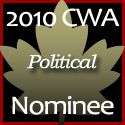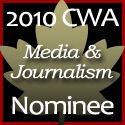Paul Dewar of the NDP worked very hard to get the Reform Conservatives to stick to Jean Chretien's plan to keep the National Portrait Gallery in the Nation's capital. Instead after flitting about, they gave the contract to Calgary. Calgary? A NATIONAL gallery in Calgary? Why were we not surprised?
However, as it turned out, the whole fiasco was a lesson in futility, wrought with lies; and we are no further ahead than we were when the campaign first started. Our gallery remains homeless and Conservative incompetence has hurt taxpayers again. When are they going to start taking an interest in Canadian culture? But then Harper doesn't believe Canada has a culture but is simply part of a larger Anglo culture, so what hope is there? Our treasures remain in a warehouse until we can elect a government that gives a damn.
Portrait gallery panel chafes at choice restrictions: documents
By Dean Beeby (CP)
November 15, 2009
OTTAWA — Members of a blue-ribbon panel created to find a home for the Portrait Gallery of Canada felt handcuffed because the federal government forbade them from examining key cost and tourism issues, says a newly released report.
The five-member panel was also misinformed at its crucial selection meeting that all five of the private-sector bids it was evaluating fully complied with federal rules - learning only months later that two did not.
The turmoil behind closed doors may help explain why the highly politicized search for a private-sector home for the portrait collection ended in a shambles a year ago, with no winning bid and the government abandoning the idea.
The Canadian Press obtained formerly secret accounts of deliberations, through requests under the Access to Information Act, after federal officials reneged on a promise to proactively release the materials.
In early 2007, the Conservative government ditched a plan by Jean Chretien's Liberal government to display the venerable portrait collection in the abandoned American embassy building on Wellington Street, facing Parliament Hill.
About $11.4 million had been spent on the project by that point, though some funds were used to remove asbestos and carry out other renovations that were needed no matter what the future use of the building. Total costs of the new gallery facility were projected in 2005 at $44.6 million.
The Tories instead announced that nine Canadian cities were eligible as a potential homes for the collection and invited private-sector bids, to encourage a public-private partnership and possibly place a cultural institution outside Ottawa.
A panel of five experts, including Canada's chief librarian and archivist Ian Wilson, was struck to evaluate bids and make recommendations. Initial expressions of interest came from 132 firms, including some in Halifax, Quebec City, Montreal and Toronto.
The deadline for submissions was changed twice, after federal officials failed to provide timely answers to basic questions from interested parties.
By May 16 last year, five formal proposals had arrived along with their $1-million deposits - from developers in Ottawa, Winnipeg, Calgary and two in Edmonton.
But panel members soon chafed when told they could not consider the costs of operating a new gallery at a distance from the storage facility in nearby Gatineau, Que., where the main collection resides.
A 2006 internal Canadian Heritage memo estimated the remote-location costs would add about $2.5 million to the $5.5-million annual operating bill of any new gallery located far from Ottawa. But this financial information was deemed non-relevant to the bid evaluations.
Panel members were also told they could not consider whether any of the five bids had strong potential for tourism growth.
Members expressed "dissatisfaction with some of the constraints," says a report by Jim Lynes, an independent consultant hired by government to monitor the process.
"There was no way to favour cities with a better potential to generate visitors for the PGC (Portrait Gallery of Canada)," says a censored version of the document.
"There was no opportunity to take the costs of a decentralized facility into consideration."
Federal officials told the panel those "constraints" could not be changed because they reflected "policy direction" from government.
A spokeswoman for Library and Archives Canada, which manages the portrait gallery, said in an interview that tourism had already been considered in creating the nine-city short list. Isabelle Vigneault also said any remaining cost issues would have been dealt with in a "second phase" of the bidding process.
Panel members held an intense selection meeting over two days in July 2008, complaining that some vital information had been provided only at the last minute. They were also given erroneous information on scoring, which cause confusion.
"Members were also concerned that they were not being given enough time to read the five submissions," says Lynes' report, which notes that all bids were officially deemed compliant with the requirements of the tender.
The panel eventually endorsed one bid (the identity is censored in the released material) on condition the government ask the developer to drop some provisions that tilted the deal too far in favour of the private-sector.
The provisions were "unacceptable in that they limited the Crown's rights and ability to act and increased the level of risk for the Crown, while at the same time limiting the risks for the developer."
Lynes' report of the deliberations added that some developers "seemed to fail to recognize that the Portrait Gallery of Canada is a national institution" - the very fear raised by some critics of the process.
The process unravelled in early November when federal lawyers deemed two of the bids - including the favoured one - non-compliant, contrary to assurances the panel was given more than three months earlier.
Lynes' final report, dated Dec. 15, 2008, concluded the bid-and-evaluation process that ultimately failed to produce a winner was technically fair and open, though had only "limited" transparency.
"Although transparency has, to this point, been limited, the planned release of the reports of the evaluation committee and the IRM (independent review monitor) will ensure that the process has been transparent," he wrote.
But the government appears to have had no such plan to proactively release the reports.
Internal Canadian Heritage media lines say the reports "will be made available through access to information," a formal procedure available to anyone wanting to access any government document.
The Canadian Press obtained heavily redacted versions of both reports through the Access to Information Act after months-long delays.
Lynes declined an interview, citing confidentiality agreements. Ian Wilson, who has since retired as librarian and archivist, also declined immediate comment.
"I continue to be bound by the post-employment code and my obligations as a former senior official," he said in an email.
The aborted bid-evaluation process cost taxpayers about $1.9 million, according to the documents.
The Portrait Gallery of Canada remains without a home, residing in the Gatineau warehouse, on a federal website and in occasional exhibitions around the country. The federal government has budgeted $3.5 million annually for the program.



No comments:
Post a Comment